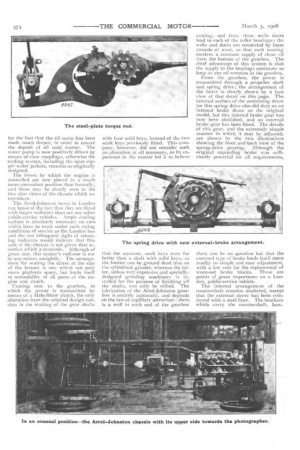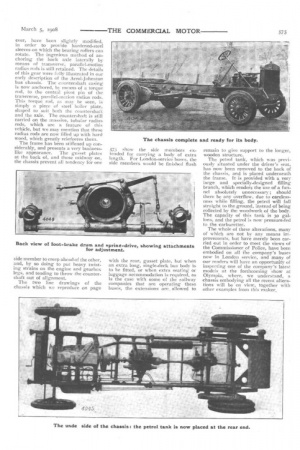The Arrol-Johnston Bus Chassis.
Page 5

Page 6

Page 7

If you've noticed an error in this article please click here to report it so we can fix it.
Some Recent Modifications in the Design of this very High-class Vehicle.
It was not to be expected that all the details of the bus chassis which is made by the New Arrol-Johnston Car Company, Limited, of Underwood, Paisley, would, after many months' operation under London public-service conditions, be found equal to the demands of those conditions, or to the ever-uncertain requirements of the Commissioner of Police of the Metropolis. In order to meet the latter, several modifications have been found necessary, and we are now enabled, by the courtesy of Mr. E. A. Rosenheim, B.Sc., M.I.A.E., the acting General Manager of the company, to outline the alterations which have been made in the construction of this chassis since the publication of the issue of " THE COMMERCIAL MOTOR," in which we illustrated and described it (9th November, 1905).
There are now some 30 buses of this make in London service, in addition to 15 at work in the provinces, and all of these, we are glad to learn, are giving very good accounts of themselves. Their silent running and low consumption of petrol—the average rate of consumption works out at one gallon for every 6.2 miles—are points worthy of special mention. As far as the engine is concerned, the alterations are of trivial character, apart from changes in the crankshaft, and the drawings which we published with our earlier description may be taken as correct for the general arrangement of the engine. The lowtension magneto has given place to a high-tension, Simms-Bosch magneto, and this, of course, necessitated some slight modification of the cylinder head, in order to accommodate the additional high-tension plug. The auxiliary system of igniton, by means of a high-tension coil, distributor, and accumulator, is still retained, for the purpose of starting the engine "on the switch." The overhead inlet valves, with their adjustable trip motion, remain unaltered. The ArrolJohnston arrangement of
placing the inlet valve over the exhaust valve allows of a minimum amount of wall -surface to a maximum amount of compression space, and this has been proved in engine design to have a great bearing upon the economical running; and;
in all probability, the low rate of petrol consumption on this maker's buses it. London is greatly due to the valve arrangement which it has adopted. The crankshaft has been stiffened up a little since the early model, and this is now made of chrome-vanadium steel, instead of the chrome-nickel steel formerly employed. All the main bearings and the big ends are lined with white metal. The Longuemare carburetter, which used to be fitted by this company, now gives place to one of its own design and manufacture, and the results obtained by it are eminently satisfactory. The lubrication of the engine remains practically unaltered, except for the fact that the oil sump has been made much deeper, in order to ensure the deposit of all solid matter. The water pump is now positively driven by means of claw couplings, otherwise the cooling system, including the spun copper water jackets, remains as originally designed.
The levers by which the engine is controlled are now placed in a much more convenient position than formally, and these may be clearly seen in the two plan views of the chassis which we reproduce.
The Arrol-Johnston buses in London can boast of the fact that they are fitted with larger radiators than are any other public-service vehicles. Ample cooling surface is absolutely necessary on cars which have to work under such trying conditions of service as the London bus and the not infrequent sight of steaming radialors would indicate that this unit of the chassis is not given that attention which it demands. Although of great size, this maker's radiator is not by any means unsightly. The arrangement for seating the driver at the Side of the bonnet is one which not only saves platform .space, but lends itself to accessibility of all parts of the engine and clutch.
Coining now to the gearbox, to which the power is transmitted by means of a Hele-Shaw clutch, the only alteration from the original design consists in the ranking of the gear shafts with four solid keys, instead of the two sunk keys previously fitted. This company, however, did not consider such an alteration at all necessary, as its experience in the matter led it to believe that the separate, sunk keys were far better than a shaft with solid keys, as the former can be ground dead true on the cylindrical grinder, whereas the latter, unless very expensive and speciallydesigned grinding machinery is installed for the purpose of finishing of the shafts, can only be milled. The lubrication of the Arrol-Johnston gearbox is entirely automatic, and depends on the law of capilliary attraction : there is a well in each end of the gearbox casting, and from these wells ducts lead to each of the roller hearings; the wells and ducts are connected by loose strands of wool, so that each bearing receives a constant supply of clean oil from the bottom of the gearbox. The chief advantage of this system is that the supply to the bearings continues so long as any oil remains in the gearbox.
From the gearbox, the power is transmitted through a propeller shaft and spring drive; the arrangement of the latter is clearly shown by a face view of that detail on this page. The internal surface of the containing drum for this spring drive also did duty as an internal brake drum on the original model, but this internal brake gear has now been abolished, and an external brake gear has been fitted. The details of this gear, and the extremely simple manner in which it may be adjusted, are shown by the two illustrations showing the front and back view of the spring-drive gearing. Although the original expanding brake was sufficiently powerful for all requirements,
there can be no question but that the external type of brake lends itself more readily to simple and easy adjustment, with a low cost for the replacement of worn-out brake blocks. These are points of great importance on a London, public-service vehicle.
The internal arrangement of the countershaft remains unaltered, except that the external sleeve has been reinforced with a steel liner. The brackets which ,carry the countershaft, how
ever, have been slightlY modified, in order to provide hardened-steel sleeves on which the bearing rollers can rotate. The ingenious method of anchoring the back axle . laterally by means of transverse, parallel-motion radius reds is still retained. The details of this gear were fully illustrated in our early description of the Arrol-Johnston bus chassis. The countershaft casing is now anchored, by means of a torque rod, to the central pivot pin of the transverse, parallel-motion radius rods. This torque rod, as may he seen, is simply a piece of steel boiler plate, shaped to suit both the countershaft and the axle. The countershaft is still carried on the massive, tubular radius rods, which are a feature of this vehicle, but we may mention that these radius rods are now filled up with hard wood, which greatly reinforces them.
The frame has been stiffened up considerably, and presents a very businesslike appearance. The gusset plates at the back of, and those midway on, the chassis prevent all tendency for one
side member to creep ahead of the other, and, by so doing to put heavy twisting -strains on the engine and gearbox legs, and tending to throw the countershaft out of alignment.
The two line drawings of the chassis which we reproduce on page 573 show the side rneMbers extended for carrying a body of extra length. For London-service buses, the side members would be finished flush
with the rear, gusset plate, but when an extra long, single-deck bus body is to be fitted, or when extra seating or luggage accommodation isrequired, as is the case with some of the railway companies that are operating these buses, the extensions arc, allowed to
remain to give support to the longer, wooden structure.
The petrol tank, which was previously situated under the driver's seat, has now been removed to the back of the chassis, and is placed underneath the frame. It is provided with a very Large and specially-designed filling branch, which renders the use of a funnel absolutely unnecessary ; should there be any overflow-, due to carelessness while filling, the petrol will fall straight to the ground, instead of being collected by the woodwork of the body. The capacity of this tank is 30 gallons, and the petrol is now pressure-fed to the carburetter.
The whole of these alterations, many of which are not by any means improvements, but have merely been carried out in order to meet the views of the Commissioner of Police, have been embodied on all the company's buses now in London service, and many of our readers will have an opportunity of inspecting one of the company's latest models at the forthcoming show at Olympia, where, we understand, a chassis embodying all the recent alterations will be on view, together with other examples from this maker.
























